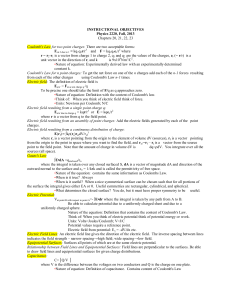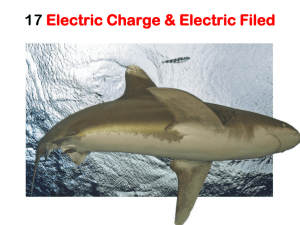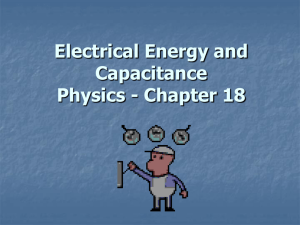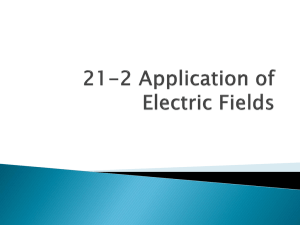Exam 1 Solutions
advertisement
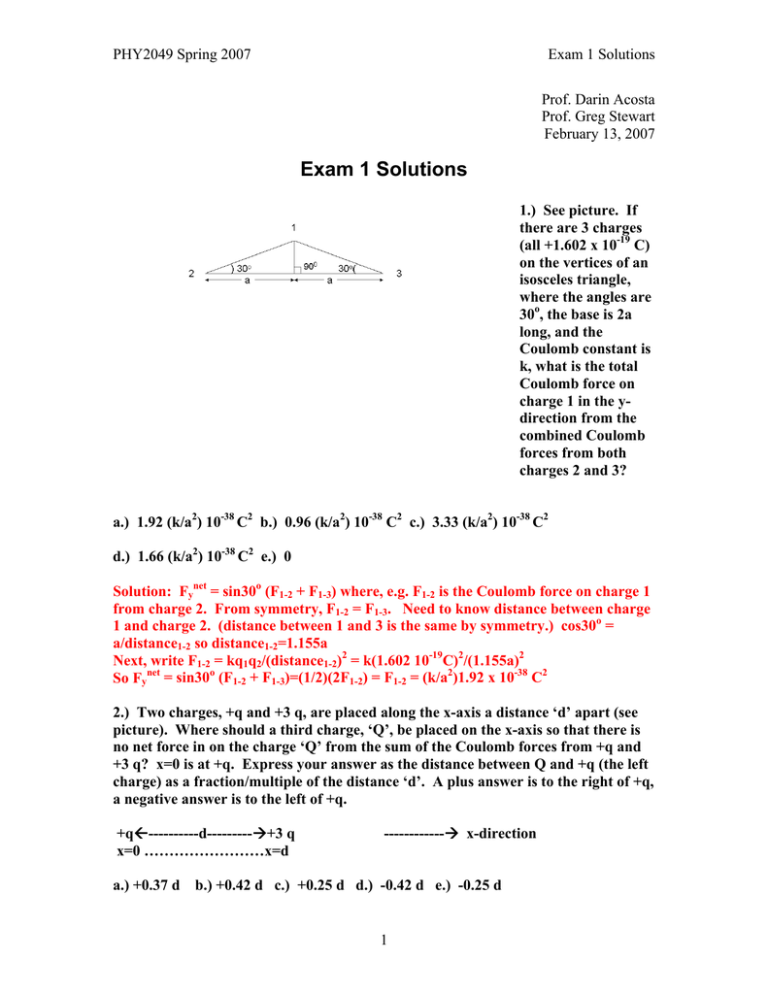
PHY2049 Spring 2007 Exam 1 Solutions Prof. Darin Acosta Prof. Greg Stewart February 13, 2007 Exam 1 Solutions 1.) See picture. If there are 3 charges (all +1.602 x 10-19 C) on the vertices of an isosceles triangle, where the angles are 30o, the base is 2a long, and the Coulomb constant is k, what is the total Coulomb force on charge 1 in the ydirection from the combined Coulomb forces from both charges 2 and 3? a.) 1.92 (k/a2) 10-38 C2 b.) 0.96 (k/a2) 10-38 C2 c.) 3.33 (k/a2) 10-38 C2 d.) 1.66 (k/a2) 10-38 C2 e.) 0 Solution: Fynet = sin30o (F1-2 + F1-3) where, e.g. F1-2 is the Coulomb force on charge 1 from charge 2. From symmetry, F1-2 = F1-3. Need to know distance between charge 1 and charge 2. (distance between 1 and 3 is the same by symmetry.) cos30o = a/distance1-2 so distance1-2=1.155a Next, write F1-2 = kq1q2/(distance1-2)2 = k(1.602 10-19C)2/(1.155a)2 So Fynet = sin30o (F1-2 + F1-3)=(1/2)(2F1-2) = F1-2 = (k/a2)1.92 x 10-38 C2 2.) Two charges, +q and +3 q, are placed along the x-axis a distance ‘d’ apart (see picture). Where should a third charge, ‘Q’, be placed on the x-axis so that there is no net force in on the charge ‘Q’ from the sum of the Coulomb forces from +q and +3 q? x=0 is at +q. Express your answer as the distance between Q and +q (the left charge) as a fraction/multiple of the distance ‘d’. A plus answer is to the right of +q, a negative answer is to the left of +q. +qÅ----------d---------Æ+3 q x=0 ……………………x=d ------------Æ x-direction a.) +0.37 d b.) +0.42 d c.) +0.25 d d.) -0.42 d e.) -0.25 d 1 PHY2049 Spring 2007 Exam 1 Solutions Solution: the charge Q, in order to be in equilibrium (not move) has to be negative and between the +q and +3q charges shown. Let the distance between Q and the left +q charge be “L”. Let the magnitude of the negative charge on Q be |Q| FCoul q-Q = -kq|Q|/L2 is the Coulomb force to the left between +q and Q (the positive +q attracts the negative Q to the left, and the sign in front takes care of this direction) FCoul 3q-Q = +k(3q)|Q|/(d-L)2 is the Coulomb force to the right between Q and +3q (the positive +3q attracts the negative Q to the right, and the sign in front takes care of this direction) If the magnitude of these two forces balances, i. e. if kq|Q|/L2 = k(3q)|Q|/(d-L)2 then Q is in equilibrium. Solving for L gives 0.366 d. 3.) Two large metal plates of area 4 m2 (i. e. square shaped with dimensions 2 m by 2 m) face each other and are close enough that you can neglect edge effects ("fringe fields"). If the metals plates have equal but opposite charges on their inner surfaces (the surfaces closer to the other plate), and if the total charge on each plate has magnitude 10-9 C, what is the magnitude of the electric field between the plates, in units of N/C? (Constants are given on the cover sheet of this test.) a.) 28 b.) 14 c.) 56 d.) 112 e.) 0 Solution: Use Gauss' law to find E using σ, the area density of charge in C/m2, as 10-9 C/4 m2, or σ=0.25 10-9 C/m2. ξ0 ∫surface E⋅dA Put cylindrical Gaussian surface so that one end cap is in the left metal plate (conductor means no E field there), have the cylinder perpendicular to the surface of the plate (this means the side dA's are perpendicular to the E field which is out perpendicular from the plate so these E⋅dA's are zero) plus E⋅dA for the end cap which is out in the field between the plates. How much charge is encluded in our Gaussian surface – just σ⋅dAend cap so . . . ξ0 ∫surface E⋅dA = ξ0 E⋅dAend cap = σ⋅dAend cap The factors of dAend cap cancel, so ξ0 E = σ so E=σ/ξ0 so E=0.25 10-9 C/m2/8.85 10-12 C2/Nm2=28 N/C 2 PHY2049 Spring 2007 Exam 1 Solutions 4.) A spherical ball (an insulator) of uniform charge density is shown with radius R. The total charge on the sphere is q. At what radius or radii from the center of the sphere is the electric field strength reduced by a factor of 9 from the electric field strength at the surface of the ball, i. e. where is E= (1/9) * q/(4πε0R2)? a.) both at 3R and 1/9 R b.) both at 3R and 1/3R c.) both at 3R and 1/27 R d.) only at 3R e.) only at 1/3 R Solution: Outside the ball, the field is just as if all of q was concentrated in the center of the ball (shell law), so one place where E is 1/9 of the surface value is where the radius is 3R, since then E = q/(4πε0(3 R)2 The other shell law tells us that the field inside the ball of uniform charge at some radius r (Gauss' law) is just from the charge inside the smaller ball, radius r. As derived in class (see section 23-9 in the text) Einside the ball= [q/(4πε0R3)]r, so another place that E is reduced by 1/9 is where r/R3 = 1/9R2, or at r=(1/9)R 5.) Suppose four charges are distributed around a point P (+q is distance 2 m above point P, -q is distance 2 m below point P, +q is distance 2 m to the right of point P, and another +q is distance 4 m to the right of point P as shown), with q=10-8 C. What is the voltage, V, in units of volts at point P from the summed influence of all four charges? a.) 67 b.) 157 c.) 90 d.) 22 e.) 0 +q | P.….+q..…+q | -q 3 PHY2049 Spring 2007 Exam 1 Solutions Solution: the potential V at point P is the scalar sum of the potential at point P from each charge: Vat P = (q/4πε0) [ 1/2m - 1/2m + 1/2m + 1/4m ] Vat P = 10-8 C * (8.99 109 Nm2/C2) (3/4m) = 67 Nm/C = 67 V 6.) A non-conducting rod (see sketch) has the magnitude of its uniform charge density λ=3 10-6 C/m. The left half of the rod is negatively charged, and the right half of the rod is positively charged. The rod is 1 m long. Taking the electric potential, V, to be 0 at infinity, what is V (in units of volts) at point P at a distance of 0.5 m above the middle of the rod along the rod’s perpendicular bisector? ↑ P | 0.5m | | | ↓------------------|++++++++++++ <- non-conducting rod, uniform charge density ←……………1 m……………→ a.) 0 b.) 47,500 c.) 23,800 d.) -47,500 e.) -23,800 Solution:Using the example in the textbook (and worked in class) and eq. 24-35, the potential above the left half line of one sign of charge is just the negative of the potential above the right half line of the other sign of charge. The two contributions cancel each other and give 0 as the right answer. 7.) Consider electric charge distributed uniformly along a one-dimensional path in the form shown as two oppositely charged sections of 1/4 of a circle each. The circle is centered at the origin. If the magnitude of the electric field at the origin (0,0) from just the left quadrant is E, what is the total x component of the electric field (Ex) at the origin (0,0) due to both the left and right quadrants? E a) √2E b) -2E c) -E/√2 d) E 4 e) 0 PHY2049 Spring 2007 Exam 1 Solutions Solution: As shown by the drawn dashed arrows, the electric field direction from the +q arc points at a 45 degree angle to the bottom right by symmetry, and the electric field from the –q arc points to the top left. The projection of each field contribution to the x axis is √2E/2, or a total field in the x-direction of √2E. 8.) In the figure shown, a small, non-conducting ball of mass m=3E-6 kg and charge q=+10 μC (distributed uniformly through its volume) hangs from an insulating thread that makes an angle θ with a vertical, uniformly charged nonconducting sheet (shown in cross section). The sheet has a surface charge density of σ=3E-11 C/m2. Considering the gravitational force of the ball and assuming that the sheet extends far vertically and into and out of the page, calculate the angle θ. FE Fg a) 30º b) 60º c) 15º d) 3º e) 45º Solution: The angle forms from the vector sum of two forces: the gravitational force down and the electric force horizontally. F qE qσ tan θ = E = = = 0.577 Fg mg 2ε 0 mg θ = 30D 9.) A 1.5 μF capacitor is charged to a potential difference of 12 V, and the charging battery is disconnected. If the charged capacitor is then connected in parallel with a second (initially uncharged) capacitor, and if the potential difference across the first capacitor subsequently drops to 9 V, what is the capacitance of this second capacitor in units of μF? a) 0.5 b) 1.5 c) 3.5 d) 2.0 5 e) 1.33 PHY2049 Spring 2007 Exam 1 Solutions Solution: The total charge is conserved, as it cannot be removed. The capacitance and potential difference does change, however: q = C1ΔV1 = ( C1 + C2 ) ΔV2 ⎛ ΔV ⎞ ⇒ ⎜ 1 − 1⎟ C1 = C2 ⎝ ΔV2 ⎠ ⎛ 12 ⎞ 3 1 ⎜ − 1⎟ = ⎝9 ⎠2 2 ⇒ C2 = 0.5μ F 10.) What is the total capacitance, in units of μF, between points A and D in the section of the circuit shown? All three capacitors have C= 1μF. a) 3/5 b) 6/7 c) 1/4 d) 4 e) 3/4 Solution: One can start with the 2 capacitors in series at the bottom left: they are in series with equivalent capacitance C/2. That is in parallel with another capacitor, so the equivalent capacitance of the 3 capacitors to the right is 3C/2. Add the first 1 1 2 5 3 capacitor in series and you get = + = ⇒ Ceq = C Ceq C 3C 3C 5 6




